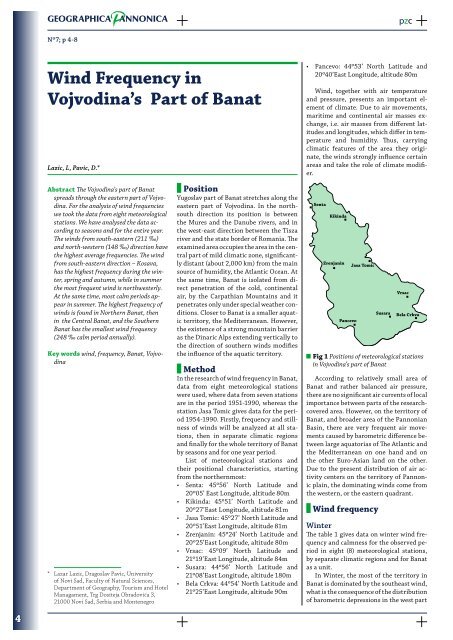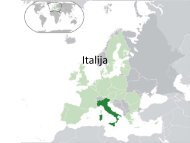Wind Frequency in Vojvodina's Part of Banat
Wind Frequency in Vojvodina's Part of Banat
Wind Frequency in Vojvodina's Part of Banat
Create successful ePaper yourself
Turn your PDF publications into a flip-book with our unique Google optimized e-Paper software.
4<br />
GEOGRAPHICA ANNONICA<br />
No7; p 4-8<br />
<strong>W<strong>in</strong>d</strong> <strong>Frequency</strong> <strong>in</strong><br />
Vojvod<strong>in</strong>a’s <strong>Part</strong> <strong>of</strong> <strong>Banat</strong><br />
Lazic, L, Pavic, D.*<br />
Abstract The Vojvod<strong>in</strong>a’s part <strong>of</strong> <strong>Banat</strong><br />
spreads through the eastern part <strong>of</strong> Vojvod<strong>in</strong>a.<br />
For the analysis <strong>of</strong> w<strong>in</strong>d frequencies<br />
we took the data from eight meteorological<br />
stations. We have analysed the data accord<strong>in</strong>g<br />
to seasons and for the entire year.<br />
The w<strong>in</strong>ds from south-eastern (211 ‰)<br />
and north-western (148 ‰) direction have<br />
the highest average frequencies. The w<strong>in</strong>d<br />
from south-eastern direction – Kosava,<br />
has the highest frequency dur<strong>in</strong>g the w<strong>in</strong>ter,<br />
spr<strong>in</strong>g and autumn, while <strong>in</strong> summer<br />
the most frequent w<strong>in</strong>d is northwesterly.<br />
At the same time, most calm periods appear<br />
<strong>in</strong> summer. The highest frequency <strong>of</strong><br />
w<strong>in</strong>ds is found <strong>in</strong> Northern <strong>Banat</strong>, then<br />
<strong>in</strong> the Central <strong>Banat</strong>, and the Southern<br />
<strong>Banat</strong> has the smallest w<strong>in</strong>d frequency<br />
(248 ‰ calm period annually).<br />
Key words w<strong>in</strong>d, frequency, <strong>Banat</strong>, Vojvod<strong>in</strong>a<br />
* Lazar Lazic, Dragoslav Pavic, University<br />
<strong>of</strong> Novi Sad, Faculty <strong>of</strong> Natural Sciences,<br />
Department <strong>of</strong> Geography, Tourism and Hotel<br />
Managament, Trg Dositeja Obradovića 3,<br />
21000 Novi Sad, Serbia and Montenegro<br />
Position<br />
Yugoslav part <strong>of</strong> <strong>Banat</strong> stretches along the<br />
eastern part <strong>of</strong> Vojvod<strong>in</strong>a. In the northsouth<br />
direction its position is between<br />
the Mures and the Danube rivers, and <strong>in</strong><br />
the west-east direction between the Tisza<br />
river and the state border <strong>of</strong> Romania. The<br />
exam<strong>in</strong>ed area occupies the area <strong>in</strong> the central<br />
part <strong>of</strong> mild climatic zone, significantly<br />
distant (about 2,000 km) from the ma<strong>in</strong><br />
source <strong>of</strong> humidity, the Atlantic Ocean. At<br />
the same time, <strong>Banat</strong> is isolated from direct<br />
penetration <strong>of</strong> the cold, cont<strong>in</strong>ental<br />
air, by the Carpathian Mounta<strong>in</strong>s and it<br />
penetrates only under special weather conditions.<br />
Closer to <strong>Banat</strong> is a smaller aquatic<br />
territory, the Mediterranean. However,<br />
the existence <strong>of</strong> a strong mounta<strong>in</strong> barrier<br />
as the D<strong>in</strong>aric Alps extend<strong>in</strong>g vertically to<br />
the direction <strong>of</strong> southern w<strong>in</strong>ds modifies<br />
the <strong>in</strong>fluence <strong>of</strong> the aquatic territory.<br />
Method<br />
In the research <strong>of</strong> w<strong>in</strong>d frequency <strong>in</strong> <strong>Banat</strong>,<br />
data from eight meteorological stations<br />
were used, where data from seven stations<br />
are <strong>in</strong> the period 1951-1990, whereas the<br />
station Jasa Tomic gives data for the period<br />
1954-1990. Firstly, frequency and stillness<br />
<strong>of</strong> w<strong>in</strong>ds will be analyzed at all stations,<br />
then <strong>in</strong> separate climatic regions<br />
and f<strong>in</strong>ally for the whole territory <strong>of</strong> <strong>Banat</strong><br />
by seasons and for one year period.<br />
List <strong>of</strong> meteorological stations and<br />
their positional characteristics, start<strong>in</strong>g<br />
from the northernmost:<br />
• Senta: 45º56’ North Latitude and<br />
20º05’ East Longitude, altitude 80m<br />
• Kik<strong>in</strong>da: 45º51’ North Latitude and<br />
20º27’East Longitude, altitude 81m<br />
• Jasa Tomic: 45º27’ North Latitude and<br />
20º51’East Longitude, altitude 81m<br />
• Zrenjan<strong>in</strong>: 45º24’ North Latitude and<br />
20º25’East Longitude, altitude 80m<br />
• Vrsac: 45º09’ North Latitude and<br />
21º19’East Longitude, altitude 84m<br />
• Susara: 44º56’ North Latitude and<br />
21º08’East Longitude, altitude 180m<br />
• Bela Crkva: 44º54’ North Latitude and<br />
21º25’East Longitude, altitude 90m<br />
pzc<br />
• Pancevo: 44º53’ North Latitude and<br />
20º40’East Longitude, altitude 80m<br />
<strong>W<strong>in</strong>d</strong>, together with air temperature<br />
and pressure, presents an important element<br />
<strong>of</strong> climate. Due to air movements,<br />
maritime and cont<strong>in</strong>ental air masses exchange,<br />
i.e. air masses from different latitudes<br />
and longitudes, which differ <strong>in</strong> temperature<br />
and humidity. Thus, carry<strong>in</strong>g<br />
climatic features <strong>of</strong> the area they orig<strong>in</strong>ate,<br />
the w<strong>in</strong>ds strongly <strong>in</strong>fluence certa<strong>in</strong><br />
areas and take the role <strong>of</strong> climate modifier.<br />
<br />
<br />
<br />
<br />
<br />
Accord<strong>in</strong>g to relatively small area <strong>of</strong><br />
<strong>Banat</strong> and rather balanced air pressure,<br />
there are no significant air currents <strong>of</strong> local<br />
importance between parts <strong>of</strong> the researchcovered<br />
area. However, on the territory <strong>of</strong><br />
<strong>Banat</strong>, and broader area <strong>of</strong> the Pannonian<br />
Bas<strong>in</strong>, there are very frequent air movements<br />
caused by barometric difference between<br />
large aquatorias <strong>of</strong> The Atlantic and<br />
the Mediterranean on one hand and on<br />
the other Euro-Asian land on the other.<br />
Due to the present distribution <strong>of</strong> air activity<br />
centers on the territory <strong>of</strong> Pannonic<br />
pla<strong>in</strong>, the dom<strong>in</strong>at<strong>in</strong>g w<strong>in</strong>ds come from<br />
the western, or the eastern quadrant.<br />
<strong>W<strong>in</strong>d</strong> frequency<br />
<br />
<br />
<br />
Fig 1 Positions <strong>of</strong> meteorological stations<br />
<strong>in</strong> Vojvod<strong>in</strong>a’s part <strong>of</strong> <strong>Banat</strong><br />
W<strong>in</strong>ter<br />
The table 1 gives data on w<strong>in</strong>ter w<strong>in</strong>d frequency<br />
and calmness for the observed period<br />
<strong>in</strong> eight (8) meteorological stations,<br />
by separate climatic regions and for <strong>Banat</strong><br />
as a unit.<br />
In W<strong>in</strong>ter, the most <strong>of</strong> the territory <strong>in</strong><br />
<strong>Banat</strong> is dom<strong>in</strong>ated by the southeast w<strong>in</strong>d,<br />
what is the consequence <strong>of</strong> the distribution<br />
<strong>of</strong> barometric depressions <strong>in</strong> the west part
<strong>of</strong> the Mediterranean on one hand and on<br />
the other the anticyclone above the south<br />
parts <strong>of</strong> Ukra<strong>in</strong>e and Besarabia. Thus, Kosava<br />
is the w<strong>in</strong>d <strong>of</strong> the highest frequency<br />
(table 1) at seven stations. <strong>Frequency</strong> <strong>of</strong><br />
southeastern w<strong>in</strong>d at these stations ranges<br />
between 185‰ (<strong>in</strong> Bela Crkva) to 318‰<br />
(<strong>in</strong> Susara). In Senta, the most frequent is<br />
northwestern w<strong>in</strong>d with 195‰. It is significant<br />
that apart from southeastern and<br />
northwestern w<strong>in</strong>ds, there is also dom<strong>in</strong>at<strong>in</strong>g<br />
southern w<strong>in</strong>d (especially <strong>in</strong> Kik<strong>in</strong>da,<br />
Zrenjan<strong>in</strong>, and Pancevo).<br />
The lowest frequencies <strong>in</strong> a large portion<br />
<strong>of</strong> <strong>Banat</strong> belong to the eastern w<strong>in</strong>d.<br />
Its m<strong>in</strong>imal frequency occurs at six stations<br />
(37‰ <strong>in</strong> Vrsac and 62‰ <strong>in</strong> Zrenjan<strong>in</strong>).<br />
In Susara, the lowest frequency is<br />
recorded for northeastern and southern<br />
w<strong>in</strong>d (25‰), and <strong>in</strong> Bela Crkva for northeastern<br />
w<strong>in</strong>d (26‰).<br />
The highest calmness dur<strong>in</strong>g w<strong>in</strong>ter occurs<br />
at four southern <strong>Banat</strong> stations, where<br />
Bela Crkva (348‰) and Susara (309‰)<br />
are s<strong>in</strong>gled out. Opposite to southern,<br />
northern and central parts <strong>of</strong> <strong>Banat</strong> represent<br />
rather w<strong>in</strong>dy areas with relatively<br />
small calmness (from 59‰ <strong>in</strong> Zrenjan<strong>in</strong><br />
to 77‰ <strong>in</strong> Senta).<br />
All three climatic regions (table 1) are<br />
dom<strong>in</strong>ated dur<strong>in</strong>g w<strong>in</strong>ter by the w<strong>in</strong>d –<br />
Kosava. The highest frequency <strong>of</strong> this w<strong>in</strong>d<br />
occurs <strong>in</strong> Central <strong>Banat</strong> (255‰), slightly<br />
lower <strong>in</strong> Southern (234‰), and the lowest<br />
<strong>in</strong> Northern (201‰). Apart from the<br />
southeastern w<strong>in</strong>d, <strong>in</strong> all three climatic regions<br />
the frequencies <strong>of</strong> northwestern and<br />
southern w<strong>in</strong>d are significant.<br />
The lowest frequency <strong>in</strong> northern, central,<br />
and southern observed parts <strong>of</strong> <strong>Banat</strong><br />
is recorded for eastern w<strong>in</strong>d (<strong>in</strong> South<br />
<strong>Banat</strong> 43‰, <strong>in</strong> Central 52‰, and <strong>in</strong> North<br />
57‰). Low frequencies are recorded for<br />
northeastern and southwestern w<strong>in</strong>d. The<br />
lowest occurrence <strong>of</strong> w<strong>in</strong>d dur<strong>in</strong>g w<strong>in</strong>ter<br />
is <strong>in</strong> South <strong>Banat</strong>, which is supported by<br />
the high value <strong>of</strong> calm 246‰. Fare more<br />
w<strong>in</strong>dy are North (calm is 68‰) and Central<br />
<strong>Banat</strong> (calm is 63‰).<br />
Observ<strong>in</strong>g the whole <strong>of</strong> <strong>Banat</strong> (table<br />
1), it is noticeable that the most dom<strong>in</strong>at<strong>in</strong>g<br />
is southeastern w<strong>in</strong>g with frequency<br />
<strong>of</strong> 227‰, and the least eastern w<strong>in</strong>d with<br />
frequency values <strong>of</strong> only 48‰ (graph 53).<br />
The high frequency is recorded with<br />
w<strong>in</strong>ds from southwestern (135‰) and<br />
southern direction (127‰), whereas low<br />
frequency characterizes northeastern<br />
(62‰) and southwestern w<strong>in</strong>ds (67‰).<br />
Calmness for the total <strong>Banat</strong> is 157‰.<br />
Spr<strong>in</strong>g<br />
Dur<strong>in</strong>g spr<strong>in</strong>g then distribution <strong>of</strong> dom<strong>in</strong>at<strong>in</strong>g<br />
w<strong>in</strong>ds undergoes slight changes.<br />
Namely, <strong>in</strong> comparison to the w<strong>in</strong>ter period<br />
<strong>in</strong>creased frequency <strong>of</strong> northwestern<br />
w<strong>in</strong>d is observed, which is yet less frequent<br />
than southeastern w<strong>in</strong>d, whereas at<br />
the same time, <strong>in</strong> most <strong>of</strong> the cases calm-<br />
pzc GEOGRAPHICA ANNONICA<br />
Table 1 Average w<strong>in</strong>ter frequencies <strong>of</strong> w<strong>in</strong>ds and calms (‰) <strong>in</strong> <strong>Banat</strong> <strong>in</strong> the period<br />
1951-1990.<br />
W<strong>in</strong>ter N NE E SE S SW W NW C<br />
Senta 118 78 58 177 107 80 110 195 77<br />
Kik<strong>in</strong>da 117 81 51 196 171 88 103 125 68<br />
Jaša Tomić 119 91 42 281 101 83 66 151 66<br />
Zrenjan<strong>in</strong> 89 74 62 230 152 63 141 130 59<br />
Vršac 88 63 37 222 207 74 75 77 157<br />
Šušara 40 25 37 318 25 29 51 166 309<br />
Bela Crkva 52 26 67 185 52 41 70 159 348<br />
Pančevo 87 62 30 210 198 76 88 79 170<br />
North <strong>Banat</strong> 108 78 57 201 143 77 118 150 68<br />
Central <strong>Banat</strong> 104 82 52 255 127 73 103 141 63<br />
South <strong>Banat</strong> 67 44 43 234 121 55 71 120 246<br />
<strong>Banat</strong> 89 62 48 227 127 67 88 135 157<br />
Source: Meteorological yearbooks 1951-1990.<br />
ness becomes lower (table 2). Thus, on the<br />
observed stations still the most dom<strong>in</strong>ant<br />
are southeastern and northwestern w<strong>in</strong>ds,<br />
whereas the lowest frequency <strong>in</strong> most <strong>of</strong><br />
the cases is recorded for the w<strong>in</strong>ds <strong>of</strong> eastern,<br />
southern and northeastern direction.<br />
At seven meteorological stations, the<br />
most frequent is southeastern w<strong>in</strong>d. As <strong>in</strong><br />
w<strong>in</strong>ter, it is only <strong>in</strong> Senta where the highest<br />
frequency is recorded for northwestern<br />
w<strong>in</strong>d. Among those seven stations, the<br />
highest frequency, 302‰, is recorded for<br />
southeastern w<strong>in</strong>d <strong>in</strong> Susara, and the lowest,<br />
184‰, <strong>in</strong> Kik<strong>in</strong>da. In Senta northwestern<br />
w<strong>in</strong>d (188‰) is more dom<strong>in</strong>ant than<br />
southeastern (165‰) for 23‰. The lowest<br />
frequency <strong>in</strong> Susara (18‰) is recorded<br />
for southern w<strong>in</strong>d, and <strong>in</strong> Bela Crkva eastern<br />
and northeastern with identical values<br />
<strong>of</strong> 29‰. All other stations record the lowest<br />
frequency <strong>of</strong> eastern w<strong>in</strong>d. The least<br />
w<strong>in</strong>dy <strong>in</strong> spr<strong>in</strong>g are Bela Crkva and Susara,<br />
and the w<strong>in</strong>diest are Kik<strong>in</strong>da, Zrenjan<strong>in</strong><br />
and Senta. This is supported by the value<br />
<strong>of</strong> calm, which is 309‰ for Bela Crkva,<br />
242‰ for Susara, whereas <strong>in</strong> Kik<strong>in</strong>da its<br />
value comes to only 52‰, <strong>in</strong> Zrenjan<strong>in</strong><br />
55‰, and <strong>in</strong> Senta 57‰.<br />
Observ<strong>in</strong>g average frequencies by climatic<br />
region it is possible to understand that <strong>in</strong><br />
all three regions the southeastern w<strong>in</strong>d is<br />
the most dom<strong>in</strong>ant, then follows northwestern,<br />
and then with lowest frequency eastern<br />
w<strong>in</strong>d, and then w<strong>in</strong>ds from northeastern<br />
and southwestern directions.<br />
The highest frequency is recorded<br />
for southeastern w<strong>in</strong>d <strong>in</strong> Central <strong>Banat</strong><br />
(249‰), then <strong>in</strong> South <strong>Banat</strong> (234‰), and<br />
the lowest <strong>in</strong> North (189‰). Northwestern<br />
w<strong>in</strong>d, observed regionally, shows noticeable<br />
standardized frequency. Namely,<br />
it is the most frequent <strong>in</strong> southern (172‰),<br />
slightly lower <strong>in</strong> northern (162‰), and the<br />
lowest <strong>in</strong> central (159‰) part <strong>of</strong> the observed<br />
area. It is also important to emphasize<br />
that the north w<strong>in</strong>d is frequent too,<br />
especially <strong>in</strong> the north and central parts <strong>of</strong><br />
<strong>Banat</strong>.<br />
Eastern w<strong>in</strong>d, which is <strong>of</strong> far lowest<br />
frequency, reaches its m<strong>in</strong>imum <strong>in</strong> South<br />
<strong>Banat</strong> (41‰), slightly higher <strong>in</strong> Central<br />
(48‰) and the highest <strong>in</strong> North (57‰). As<br />
it has been quoted here, relatively low frequencies<br />
characterize northeastern and<br />
southwestern w<strong>in</strong>ds.<br />
The most w<strong>in</strong>dy parts are the north<br />
parts <strong>of</strong> <strong>Banat</strong> where the value <strong>of</strong> calm is<br />
only 55‰, central parts follow immediately<br />
with calm 65‰, whereas the least<br />
w<strong>in</strong>dy parts are those <strong>in</strong> the south <strong>of</strong> the<br />
observed area where the frequency is the<br />
highest (199‰).<br />
Table 2 Average spr<strong>in</strong>g frequencies <strong>of</strong> w<strong>in</strong>ds and calms (‰) <strong>in</strong> <strong>Banat</strong> <strong>in</strong> the period<br />
1951-1990.<br />
Spr<strong>in</strong>g N NE E SE S SW W NW C<br />
Senta 145 84 57 165 113 90 101 188 57<br />
Kik<strong>in</strong>da 138 93 55 184 124 96 98 160 52<br />
Jaša Tomić 121 86 38 282 73 88 57 180 75<br />
Zrenjan<strong>in</strong> 123 72 58 217 134 73 130 138 55<br />
Vršac 101 90 39 221 159 72 83 101 134<br />
Šušara 40 30 45 302 18 30 69 224 242<br />
Bela Crkva 61 29 29 192 61 58 87 174 309<br />
Pančevo 103 79 49 223 90 57 99 190 110<br />
North <strong>Banat</strong> 135 83 57 189 124 86 110 162 55<br />
Central <strong>Banat</strong> 122 79 48 249 103 81 94 159 65<br />
South <strong>Banat</strong> 76 57 41 234 82 54 85 172 199<br />
<strong>Banat</strong> 104 70 46 223 97 71 91 169 129<br />
Source: Meteorological yearbooks 1951-1990.<br />
Lazic, L.<br />
Pavic, D.<br />
5
<strong>W<strong>in</strong>d</strong> <strong>Frequency</strong> <strong>in</strong> Vojvod<strong>in</strong>a’s <strong>Part</strong> <strong>of</strong> <strong>Banat</strong><br />
6<br />
GEOGRAPHICA ANNONICA<br />
Table 3 Mean summer w<strong>in</strong>d frequency and calm (‰) <strong>in</strong> <strong>Banat</strong> for the period 1951-1990.<br />
Summer N NE E SE S SW W NW C<br />
Senta 129 89 53 133 100 85 121 192 98<br />
Kik<strong>in</strong>da 130 97 58 145 92 79 117 187 95<br />
Jaša Tomić 127 81 48 179 65 85 65 225 125<br />
Zrenjan<strong>in</strong> 127 80 58 141 104 73 163 174 80<br />
Vršac 116 80 43 138 134 80 94 123 192<br />
Šušara 83 54 39 129 79 79 114 123 300<br />
Bela Crkva 51 29 36 103 40 54 123 160 404<br />
Pančevo 97 73 48 151 122 91 100 118 200<br />
North <strong>Banat</strong> 129 89 56 140 99 79 134 184 91<br />
Central <strong>Banat</strong> 127 80 53 160 84 79 114 200 103<br />
South <strong>Banat</strong> 87 59 41 130 94 76 108 131 274<br />
<strong>Banat</strong> 107 73 48 140 92 78 112 163 187<br />
Source: Meteorological yearbooks 1951-1990.<br />
On the area <strong>of</strong> the whole <strong>Banat</strong> (table<br />
2) the most dom<strong>in</strong>ant are southeastern<br />
(223‰), and northwestern w<strong>in</strong>ds<br />
(169‰), and the least frequent w<strong>in</strong>ds<br />
from the eastern (46‰), northeastern<br />
(70‰), and southwestern (71‰) directions.<br />
The number <strong>of</strong> calmness is significant<br />
- 129‰.<br />
Summer<br />
Highly noticeable changes <strong>in</strong> w<strong>in</strong>d frequency<br />
distribution are recorded dur<strong>in</strong>g<br />
summer <strong>in</strong> comparison to w<strong>in</strong>ter and<br />
spr<strong>in</strong>g period, what primarily refers to significant<br />
<strong>in</strong>crease <strong>in</strong> northwestern and decrease<br />
<strong>in</strong> southeastern w<strong>in</strong>d occurrence.<br />
Accord<strong>in</strong>g to Katic et all (1979), this is the<br />
consequence <strong>of</strong> high air pressure values<br />
above the Atlantic Ocean and low air pressure<br />
values above Central Asia, as well as<br />
<strong>of</strong> frequent passes <strong>of</strong> barometric depressions<br />
above the Adriatic and Mediterranean.<br />
Thus, at five measure stations (Senta,<br />
Kik<strong>in</strong>da, Jasa Tomic, Zrenjan<strong>in</strong>, and Bela<br />
Crkva) the highest occurrence is recorded<br />
for northwestern w<strong>in</strong>d, whereas at other<br />
three measure stations (Vrsac, Susara,<br />
and Pancevo) it is recorded for southeastern<br />
w<strong>in</strong>d well known as Kosava (table 3).<br />
Northwestern w<strong>in</strong>d frequency values at<br />
five-mentioned measure stations range<br />
from 160‰ (Bela Crkva) to 225‰ (Jasa<br />
Tomic), whereas southeastern w<strong>in</strong>d frequency<br />
values range from 151‰ (Pancevo),<br />
138‰ (Vrsac) to 129‰ (Susara). It<br />
is important to emphasize that apart from<br />
those w<strong>in</strong>ds rather frequent distribution<br />
is recorded for w<strong>in</strong>ds <strong>of</strong> north and west directions.<br />
The lowest frequency rate, which is the<br />
same as <strong>in</strong> two earlier seasons, are recorded<br />
even at seven measure stations for eastern<br />
w<strong>in</strong>d (rang<strong>in</strong>g from 39‰ Susara, to<br />
58‰ Kik<strong>in</strong>da and Zrenjan<strong>in</strong>). It is only <strong>in</strong><br />
Bela Crkva where the lowest occurrence<br />
rate is recorded for northeastern w<strong>in</strong>d<br />
(29‰) which is 7‰ less than recorded for<br />
the eastern w<strong>in</strong>d. Dur<strong>in</strong>g summer, other<br />
w<strong>in</strong>ds <strong>of</strong> relatively low frequency are recorded<br />
at measure stations, e.g. south-<br />
western w<strong>in</strong>d (Senta, Kik<strong>in</strong>da, Zrenjan<strong>in</strong>)<br />
and western (Jasa Tomic).<br />
The significant feature <strong>of</strong> summer period<br />
is <strong>in</strong>crease <strong>in</strong> calmness, which, dur<strong>in</strong>g<br />
this warmest season <strong>in</strong> <strong>Banat</strong>, ranges from<br />
80‰ (Zrenjan<strong>in</strong>) to remarkably 404‰<br />
(Bela Crkva).<br />
There are no significant deviations by<br />
climatic regions (table 3). The most dom<strong>in</strong>ant<br />
w<strong>in</strong>ds <strong>in</strong> all three regions are northwestern,<br />
then follow southeastern, whereas<br />
the lowest frequency <strong>in</strong> all three regions<br />
is recorded for eastern w<strong>in</strong>d, and then for<br />
w<strong>in</strong>ds from southwestern and northeastern<br />
directions.<br />
The highest frequency <strong>of</strong> 200‰ is recorded<br />
for the northwestern w<strong>in</strong>d <strong>in</strong> Central<br />
<strong>Banat</strong>, whereas <strong>in</strong> North <strong>Banat</strong> frequency<br />
<strong>of</strong> this w<strong>in</strong>d is 184‰, and <strong>in</strong> South<br />
<strong>Banat</strong> 131‰. Southeastern w<strong>in</strong>d, which<br />
lags beh<strong>in</strong>d the northwestern <strong>in</strong> frequency<br />
value, has the same frequency distribution<br />
by climatic regions. Namely, its frequency<br />
<strong>in</strong> Central <strong>Banat</strong> is 160‰, <strong>in</strong> North <strong>Banat</strong><br />
140‰, and <strong>in</strong> South 130‰. Also, north<br />
and west w<strong>in</strong>ds have significant frequency<br />
distribution <strong>in</strong> North and Central <strong>Banat</strong>.<br />
East w<strong>in</strong>d, which is the most rare dur<strong>in</strong>g<br />
this season, records the lowest frequency<br />
<strong>in</strong> South <strong>Banat</strong> (41‰), slightly higher <strong>in</strong><br />
Central (53‰) and North <strong>Banat</strong> (56‰).<br />
Dur<strong>in</strong>g summer, South <strong>Banat</strong> with<br />
calm <strong>of</strong> 274‰ represents the part <strong>of</strong> the<br />
pzc<br />
researched area with lowest w<strong>in</strong>d frequency.<br />
<strong>W<strong>in</strong>d</strong>ier are Central (calm 103‰) and<br />
northern parts <strong>of</strong> <strong>Banat</strong> (calm 91‰).<br />
On the whole region <strong>of</strong> <strong>Banat</strong> (table 3),<br />
the most prevail<strong>in</strong>g w<strong>in</strong>ds are northwestern<br />
(163‰) and southeastern (140‰)<br />
w<strong>in</strong>ds, whereas the lowest frequency is recorded<br />
for eastern w<strong>in</strong>d (48‰). Low distribution<br />
is recorded for northeastern (73‰)<br />
and southwestern (78‰) w<strong>in</strong>ds.<br />
Autumn<br />
Dur<strong>in</strong>g autumn, the distribution <strong>of</strong> anticyclone<br />
and cyclone <strong>in</strong> broader district is<br />
such that aga<strong>in</strong> on the territory <strong>of</strong> <strong>Banat</strong><br />
the most frequent is southeastern w<strong>in</strong>d,<br />
far more than dur<strong>in</strong>g w<strong>in</strong>ter and spr<strong>in</strong>g<br />
(table 4). All eight measure stations record<br />
the dom<strong>in</strong>ance <strong>of</strong> southeastern w<strong>in</strong>d. Its<br />
frequency ranges from 206 ‰ (Senta) to<br />
333‰ (Susara). The second place <strong>in</strong> frequency<br />
is shared between northwestern<br />
(Senta, Jasa Tomic, Susara, Bela Crkva,<br />
and Pancevo) and southern (Kik<strong>in</strong>da,<br />
Zrenjan<strong>in</strong>, and Vrsac) w<strong>in</strong>ds. Accord<strong>in</strong>g<br />
to earlier researches (Katic et all. 1979)<br />
southern w<strong>in</strong>d <strong>in</strong> <strong>Banat</strong> <strong>in</strong> w<strong>in</strong>ter shows<br />
higher frequency distribution <strong>in</strong> comparison<br />
to other seasons.<br />
Eastern w<strong>in</strong>d is the least frequent <strong>in</strong> autumn<br />
<strong>in</strong> most <strong>of</strong> <strong>Banat</strong>. Namely, <strong>in</strong> Senta<br />
(62‰), Vrsac (44‰), and Pancevo (332‰)<br />
the lowest frequencies were recorded,<br />
whereas at measure station Jasa Tomic<br />
together with western w<strong>in</strong>d (53‰), and<br />
<strong>in</strong> Zrenjan<strong>in</strong> (66‰) together with southwestern<br />
w<strong>in</strong>d it records the lowest frequency.<br />
In Kik<strong>in</strong>da (64‰) and Bela Crkva<br />
(22‰), the lowest frequency was recorded<br />
for northeastern, and <strong>in</strong> Susara (22‰0<br />
southern w<strong>in</strong>d. It is also important to say<br />
that at measure stations <strong>of</strong> South <strong>Banat</strong>,<br />
apart form southeastern, <strong>in</strong> Susara apart<br />
from northwestern, and <strong>in</strong> Pancevo apart<br />
from southern w<strong>in</strong>ds, the w<strong>in</strong>ds from<br />
other directions recorded extremely low<br />
frequencies. Here calms are rather frequent<br />
and range from 160‰ <strong>in</strong> Vrsac to<br />
421‰ <strong>in</strong> Bela Crkva. Calms <strong>in</strong> the northern<br />
and Central parts <strong>of</strong> <strong>Banat</strong> are <strong>of</strong> significantly<br />
lower frequency, which rang-<br />
Table 4 Mean autumn w<strong>in</strong>d frequency and calm (‰) <strong>in</strong> <strong>Banat</strong> for the period 1951-1990.<br />
Autumn N NE E SE S SW W NW C<br />
Senta 109 74 62 206 123 81 101 178 66<br />
Kik<strong>in</strong>da 116 64 66 231 144 85 94 130 70<br />
Jaša Tomić 100 94 53 295 79 81 53 155 90<br />
Zrenjan<strong>in</strong> 92 70 66 245 147 66 128 121 65<br />
Vršac 88 73 44 244 172 62 73 84 160<br />
Šušara 33 29 55 333 22 26 44 139 319<br />
Bela Crkva 33 22 59 208 48 44 77 88 421<br />
Pančevo 51 63 32 270 190 60 53 91 190<br />
North <strong>Banat</strong> 106 69 65 227 138 77 108 143 67<br />
Central <strong>Banat</strong> 96 82 59 270 113 73 91 138 78<br />
South <strong>Banat</strong> 51 47 47 264 108 48 62 100 273<br />
<strong>Banat</strong> 78 61 55 254 116 63 78 123 172<br />
Source: Meteorological yearbooks 1951-1990.
es from 65‰(Zrenjan<strong>in</strong>) to 90‰ (Jasa<br />
Tomic).<br />
In all three climatic regions (table 4)<br />
the most dom<strong>in</strong>ant is southeastern w<strong>in</strong>d,<br />
whereas w<strong>in</strong>ds from eastern and northeastern<br />
direction blow quite rarely. Southeastern<br />
w<strong>in</strong>d records the highest frequency<br />
<strong>in</strong> Central <strong>Banat</strong> (270‰), <strong>in</strong> Southern<br />
<strong>Banat</strong> 6‰, less which is (264‰), and the<br />
least <strong>in</strong> the northern part <strong>of</strong> the area covered<br />
by the research (227‰). By the frequency<br />
<strong>of</strong> occurrence right beh<strong>in</strong>d southeastern<br />
w<strong>in</strong>d <strong>in</strong> North and Central <strong>Banat</strong>,<br />
there is the w<strong>in</strong>d from northwestern, and<br />
<strong>in</strong> South <strong>Banat</strong> the w<strong>in</strong>d from southern direction.<br />
The lowest frequency rate <strong>of</strong> 47‰ is<br />
recorded for eastern w<strong>in</strong>d, together with<br />
western <strong>in</strong> the southern part <strong>of</strong> <strong>Banat</strong>,<br />
whereas <strong>in</strong> the central area (59‰) and<br />
<strong>in</strong> the northern parts (65‰) <strong>of</strong> the researched<br />
area eastern w<strong>in</strong>d occupies the<br />
last place by frequency. It is easily observed<br />
that <strong>in</strong> South <strong>Banat</strong>, w<strong>in</strong>ds from<br />
directions other than southeast, partly<br />
south and northwest are <strong>of</strong> low distribu-<br />
tion. As it has already been said, calms are<br />
the most frequent here (273‰), whereas<br />
<strong>in</strong> the central (78‰) and <strong>in</strong> northern<br />
(67‰) parts <strong>of</strong> the researched area they<br />
are <strong>of</strong> lower frequency. On the whole territory<br />
<strong>of</strong> <strong>Banat</strong> (table 4), accord<strong>in</strong>g to expectations,<br />
the most dom<strong>in</strong>ant is the southeastern<br />
w<strong>in</strong>d (254‰), then follow w<strong>in</strong>ds<br />
from northwestern direction (123‰), and<br />
southern (116‰) direction. Conversely,<br />
the lowest frequency shows eastern<br />
(55‰), northeastern (61‰), and southwestern<br />
(63‰) w<strong>in</strong>ds (graph 59). The average<br />
calm for the whole <strong>Banat</strong> is 172‰.<br />
Annual<br />
Mean annual w<strong>in</strong>d frequency and calm <strong>in</strong><br />
<strong>Banat</strong> represent the result <strong>of</strong> the exist<strong>in</strong>g<br />
view <strong>of</strong> frequency and clam by seasons. On<br />
the basis <strong>of</strong> annual mean values it is difficult<br />
to def<strong>in</strong>e the correlation between frequency<br />
<strong>of</strong> w<strong>in</strong>ds from different directions,<br />
as well as frequency <strong>of</strong> calm by seasons,<br />
which undoubtedly exist.<br />
Accord<strong>in</strong>g to data <strong>in</strong> table 5, on the<br />
whole area covered, the most dom<strong>in</strong>ant are<br />
w<strong>in</strong>ds from southeastern and northwestern<br />
direction, whereas the least frequent<br />
are w<strong>in</strong>ds from eastern and northeast-<br />
Table 5 Mean annual w<strong>in</strong>d frequency and calm (‰) <strong>in</strong> <strong>Banat</strong> for the period 1951-1990.<br />
Annual N NE E SE S SW W NW C<br />
Senta 125 81 58 170 111 84 108 188 75<br />
Kik<strong>in</strong>da 125 84 58 189 133 87 103 150 71<br />
Jaša Tomić 117 88 45 259 80 84 60 178 89<br />
Zrenjan<strong>in</strong> 108 74 61 208 134 69 140 141 65<br />
Vršac 98 77 41 206 168 72 81 96 161<br />
Šušara 49 34 44 270 36 41 70 163 293<br />
Bela Crkva 49 27 48 172 50 49 89 145 371<br />
Pančevo 84 69 40 214 150 71 85 119 168<br />
North <strong>Banat</strong> 119 80 59 189 126 80 117 160 70<br />
Central <strong>Banat</strong> 112 81 53 234 107 77 100 159 77<br />
South <strong>Banat</strong> 70 52 43 216 101 58 81 131 248<br />
<strong>Banat</strong> 94 67 49 211 108 70 92 148 161<br />
Source: Meteorological yearbooks 1951-1990.<br />
<br />
<br />
<br />
<br />
<br />
<br />
<br />
<br />
<br />
ern direction. At seven measure stations,<br />
the most frequent dur<strong>in</strong>g a year is southeastern<br />
w<strong>in</strong>d (from 172‰ <strong>in</strong> Bela Crkva<br />
to 270‰ <strong>in</strong> Susara), whereas <strong>in</strong> Senta the<br />
most dom<strong>in</strong>ant is northwestern w<strong>in</strong>d with<br />
pzc GEOGRAPHICA ANNONICA<br />
<br />
Fig 2 Average annual w<strong>in</strong>ds and calm periods (‰) for the Northern, Central and Southern<br />
<strong>Banat</strong> <strong>in</strong> the period 1951-1990.<br />
<br />
<br />
<br />
<br />
<br />
<br />
frequency <strong>of</strong> 188‰ (southeastern w<strong>in</strong>d <strong>in</strong><br />
Senta is less frequent than northwestern<br />
w<strong>in</strong>d for 18‰). It is important to emphasize<br />
that <strong>in</strong> Vrsac (168‰) and <strong>in</strong> Pancevo<br />
(150‰), the occurrence <strong>of</strong> southern w<strong>in</strong>d<br />
is rather frequent.<br />
At six measure stations the least frequent<br />
are the w<strong>in</strong>ds from eastern direction<br />
(40‰ <strong>in</strong> Pancevo and 61‰ <strong>in</strong> Zrenjan<strong>in</strong>),<br />
and northeastern direction (34‰<br />
Susara and 27‰ Bela Crkva). Besides the<br />
aforementioned, relatively low frequency<br />
is recorded for southwestern (Zrenjan<strong>in</strong>,<br />
Vrsac), southern (Susara) and western<br />
(Jasa Tomic) w<strong>in</strong>ds.<br />
The highest frequency <strong>of</strong> mean annual<br />
calm is recorded at measure stations <strong>in</strong><br />
the south <strong>of</strong> <strong>Banat</strong> (from 161‰ <strong>in</strong> Vrsac to<br />
371‰ <strong>in</strong> Bela Crkva), whereas calm at stations<br />
<strong>in</strong> North and Central <strong>Banat</strong> far less<br />
frequent and its occurrence ranges from<br />
65v (Zrenjan<strong>in</strong>) to 89‰ (Jasa Tomic).<br />
The highest mean annual frequencies <strong>in</strong><br />
all three climatic regions (table 5) belong<br />
to southeastern and northwestern w<strong>in</strong>ds.<br />
The lowest mean annual frequencies belong<br />
to eastern, southwestern and northeastern<br />
w<strong>in</strong>ds.<br />
<br />
Fig 3 Average annual w<strong>in</strong>ds and calm periods (‰) for <strong>Banat</strong> <strong>in</strong> the period 1951-1990.<br />
Lazic, L.<br />
Pavic, D.<br />
7
<strong>W<strong>in</strong>d</strong> <strong>Frequency</strong> <strong>in</strong> Vojvod<strong>in</strong>a’s <strong>Part</strong> <strong>of</strong> <strong>Banat</strong><br />
8<br />
GEOGRAPHICA ANNONICA<br />
Southeastern w<strong>in</strong>d shows the highest<br />
frequency <strong>in</strong> Central <strong>Banat</strong> (234‰),<br />
slightly lower <strong>in</strong> South (216‰), and the<br />
lowest <strong>in</strong> North (189‰). Annual frequencies<br />
<strong>of</strong> northwestern w<strong>in</strong>d gradually decrease<br />
from southwards (from 160‰ to<br />
131‰). Significant frequency <strong>of</strong> occurrence<br />
<strong>in</strong> North and Central <strong>Banat</strong> is recorded<br />
for w<strong>in</strong>ds from north and west direction.<br />
Eastern w<strong>in</strong>d shows the lowest frequency<br />
<strong>in</strong> all three regions and its values<br />
decreases southwards (from 59‰ to<br />
43‰). Low frequency, especially <strong>in</strong> South<br />
<strong>Banat</strong>, is recorded for northeastern (52‰)<br />
and southwestern (58‰) w<strong>in</strong>ds. The highest<br />
annual calm is recorded for southern<br />
parts <strong>of</strong> <strong>Banat</strong> (248‰), whereas <strong>in</strong> Central<br />
(77‰) and <strong>in</strong> North <strong>Banat</strong> (70‰) the<br />
value <strong>of</strong> calm is lower.<br />
On the whole area <strong>of</strong> <strong>Banat</strong> the highest<br />
mean annual frequency (table 5) is recorded<br />
for w<strong>in</strong>ds from southeastern (211‰)<br />
and northwestern (148‰) directions,<br />
and the lowest mean annual frequency is<br />
recorded for w<strong>in</strong>ds from eastern (49‰),<br />
northeastern (67‰) and southwestern<br />
(70‰) direction. The value <strong>of</strong> mean annual<br />
calm is 161 ‰.<br />
Conclusion<br />
Analyz<strong>in</strong>g the data, it is possible to say<br />
that dur<strong>in</strong>g the year on the whole territory<br />
<strong>of</strong> Vojvod<strong>in</strong>ian part <strong>of</strong> <strong>Banat</strong>, the w<strong>in</strong>ds<br />
<strong>of</strong> highest frequency are those from southeastern<br />
(211‰) and northwestern (148‰)<br />
quadrant. The w<strong>in</strong>d from the southeastern<br />
quadrant - Kosava has the highest frequency<br />
value dur<strong>in</strong>g w<strong>in</strong>ter, spr<strong>in</strong>g, and<br />
autumn, whereas <strong>in</strong> summer the most<br />
frequent w<strong>in</strong>d is that from northwestern<br />
pzc<br />
quadrant. At the same time, the highest<br />
calm occurs dur<strong>in</strong>g the summer period.<br />
The highest w<strong>in</strong>d frequency was recorded<br />
for North <strong>Banat</strong>, then for Central<br />
<strong>Banat</strong>, and the lowest values were recorded<br />
for South <strong>Banat</strong> (248‰ annually).<br />
References<br />
Dukic, D. (1981), Klimatologija, Naucna<br />
knjiga, Beograd.<br />
Katic,P., Djukanovic, D., Djakovic., (1979),<br />
Klima SAP Vojvod<strong>in</strong>e, Poljoprivredni<br />
fakultet, Novi Sad.<br />
Meteoroloski godisnjaci (1951-1990),<br />
Savezni hidrometeoroloski zavod, Novi<br />
Sad.<br />
Milosavljevic, M. (1951), Klimatografska<br />
skica NR Srbije, Institut za vodoprivredu,<br />
Beograd.<br />
Vujevic, P. (1948), Meteorologija, Prosveta,<br />
Beograd.
















